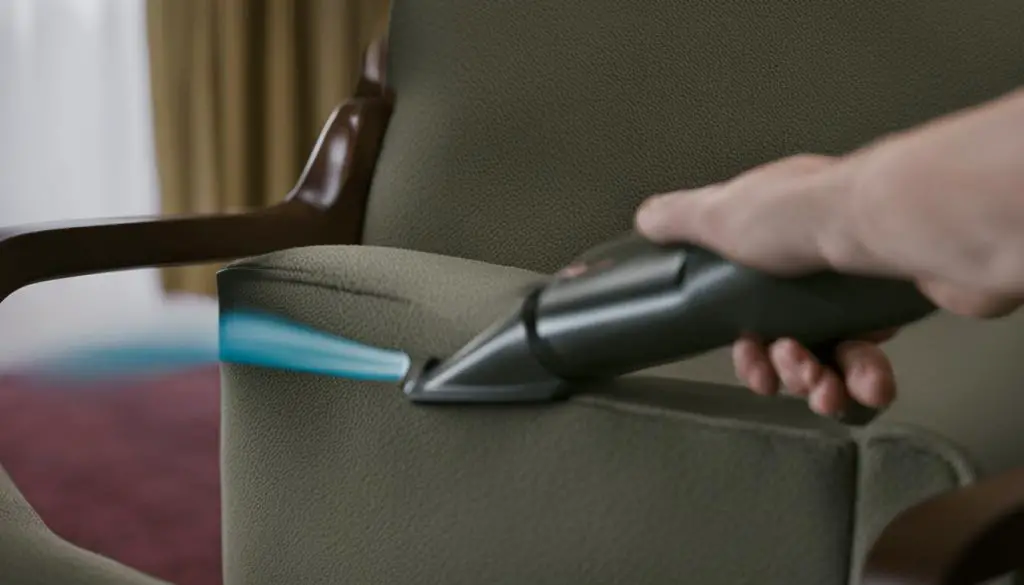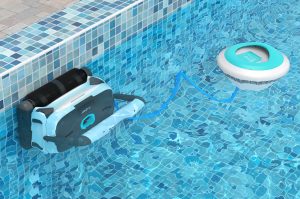Upholstered dining chairs are a beautiful addition to any dining room, providing both comfort and style. However, over time, these chairs can accumulate dirt, stains, and spills, which can detract from their overall appearance. To keep your dining room chairs looking spotless, it’s paramount to know how to clean upholstered chairs effectively.
Whether you’re dealing with food crumbs, beverage spills, or general wear and tear, this guide will walk you through step-by-step instructions on how to restore your upholstered dining chairs to their original beauty. From understanding upholstery codes to spot cleaning stains and deep cleaning the entire upholstery, we’ve got you covered; you can watch the embedded video below.
Key Takeaways:
- Regularly vacuuming your upholstered dining chairs helps to remove surface dirt and debris.
- Understanding the upholstery codes is crucial for selecting the appropriate cleaning method.
- Spot cleaning tough stains with a suitable stain remover is essential before deep cleaning.
- Cleaning the entire upholstery using a soapy mixture and a soft-bristled brush rejuvenates the fabric.
- Proper rinsing and drying techniques ensure residue-free and well-maintained upholstered dining chairs.
Understanding Upholstery Codes
Before you begin cleaning your upholstered dining chairs, it’s essential to understand the upholstery codes. Furniture manufacturers attach tags to chairs that provide cleaning guidelines based on the fabric. These codes include:
- W: Indicates that water-based cleaning solvents can be used to clean the upholstery.
- S: Indicates that dry cleaning solvents should be used for cleaning.
- W-S: Indicates that both water-based and solvent-based products are safe to use.
- X: Indicates that professional cleaning is required and no household cleaning solutions should be used.
If your upholstered dining chairs do not have a tag or the tag is missing, it’s necessary to test cleaning solutions in an unnoticeable area to see how the fabric reacts.
Understanding the upholstery codes ensures that you use the appropriate cleaning methods and products, preventing any damage to the fabric. Now that you’re familiar with the codes, let’s move on to the cleaning process to keep your upholstered dining chairs in pristine condition.
Vacuuming and Removing Surface Dirt
The first step in cleaning upholstered dining chairs is to vacuum them to remove surface-level dirt and debris. Vacuuming not only helps remove loose particles but also prepares the chairs for deeper cleaning.
To effectively vacuum your upholstered dining chairs, follow these steps:
- Attach the upholstery attachment or a brush attachment to your vacuum cleaner.
- Gently sweep the upholstery from top to bottom, ensuring you cover all areas.
- Pay special attention to the notches and corners of the chairs, where dirt and crumbs tend to accumulate.
- Remove loose crumbs, debris, and hair that may be trapped in the upholstery.
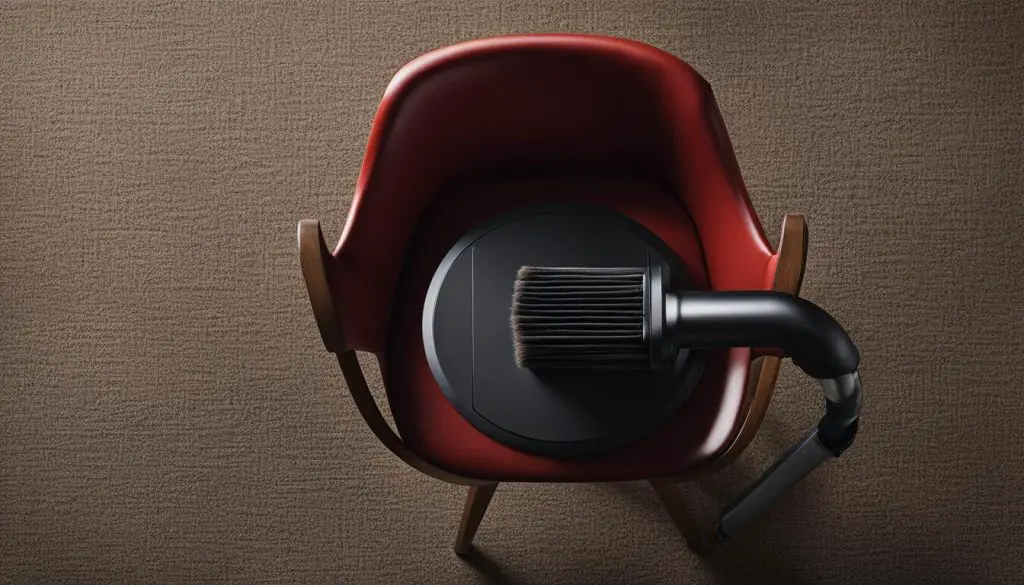
Spot Cleaning Stains
To tackle tough stains on your upholstered dining chairs, spot cleaning is necessary. Whether it’s an accidental spill or a stubborn mark, a targeted approach can help remove the stain effectively. You have two options: using a store-bought stain spot treatment or creating a homemade solution using household ingredients like hydrogen peroxide or white vinegar.
Store-bought Stain Spot Treatment:
If you choose a store-bought stain spot treatment, make sure to follow the instructions on the product label. These treatments are specifically formulated to break down tough stains and are readily available in most supermarkets or home improvement stores.
Homemade Solution:
If you prefer a DIY approach, you can create a homemade stain remover using household items. Try using a mixture of equal parts hydrogen peroxide and water or a solution of white vinegar and water. These ingredients can help lift and dissolve various types of stains.
Here’s how you can apply the stain remover:
- Dab a clean cloth with the stain remover of your choice.
- Gently blot the stained area; be careful not to rub the stain further into the fabric.
- Let the stain remover sit on the stain for about 10 minutes. This allows the solution to penetrate the fabric and break down the stain.
While the stain remover works its magic, you can move on to the next step of the cleaning process. But before we do that, let’s take a quick look at the benefits of using hydrogen peroxide and white vinegar in homemade stain removers:
| Hydrogen Peroxide | White Vinegar |
|---|---|
| Natural stain remover | Effective in removing odors |
| Gentle on most fabrics | Acts as a disinfectant |
| Can help remove blood, wine, and food stains | Gentle on colored fabrics |
The homemade stain remover provides an affordable and eco-friendly alternative to store-bought options, allowing you to effectively deal with stains while minimizing potential damage to your upholstery.
In the next section, we’ll discuss the crucial step of cleaning the entire upholstery of your dining chairs.
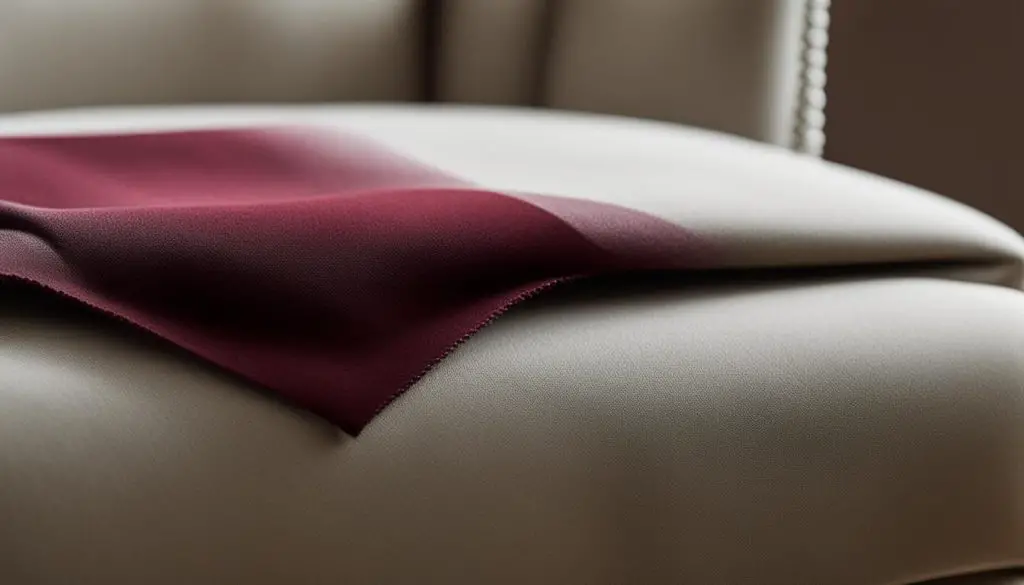
Cleaning the Upholstery
After spot cleaning, it’s time to clean the entire upholstery of the dining chairs. To start, create a soapy mixture using warm water and a mild detergent. This gentle yet effective solution will help break down dirt and stains without damaging the fabric.
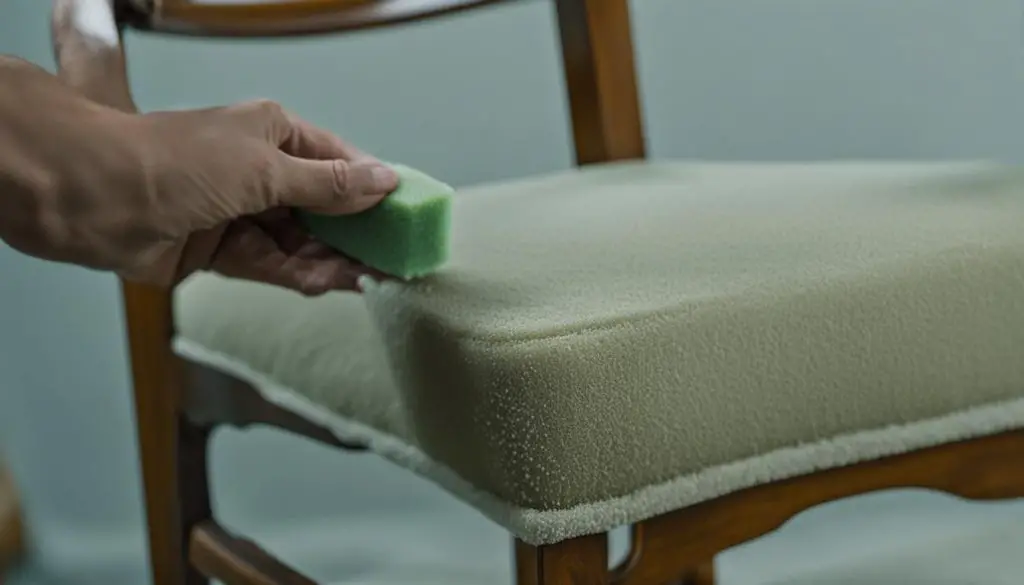
Next, dampen a cloth with the soapy mixture and begin gently scrubbing the upholstery in small circles. Start from the top of the chair and work your way down, ensuring that you cover every surface. This method allows the soapy mixture to penetrate deep into the fabric, lifting away grime and leaving your upholstery refreshed.
If you come across heavily soiled areas that require extra attention, consider using a soft-bristled brush. The bristles will help dislodge stubborn dirt and stains, enabling the soapy mixture to work its magic more effectively.
If you have access to a steam cleaner, this is another excellent option for deep cleaning upholstery. The hot steam helps to sanitize and eliminate bacteria, leaving your dining chairs looking and feeling like new. When using a steam cleaner, move the nozzle in a crisscross pattern, focusing on heavily soiled areas for maximum cleaning power.
Tips for Cleaning Upholstery:
- Create a soapy mixture using warm water and mild detergent
- Gently scrub the upholstery in small circles, working from top to bottom
- Use a soft-bristled brush for heavily soiled areas
- Consider using a steam cleaner for deep cleaning
Rinsing and Drying
After cleaning your upholstered dining chairs, it’s essential to rinse the upholstery to remove any leftover detergent. This step ensures that no cleaning solution residue remains, leaving your chairs looking clean and fresh.
Start by dampening a clean cloth with water. Gently blot the upholstery surface, focusing on the areas where you applied the cleaning solution. Repeat this step with multiple clean cloths until you no longer see any soapy residue on the cloth.
To speed up the drying process, it’s best to air dry your chairs in a well-ventilated area. Choose a spot away from direct sunlight or heat sources as they can potentially damage the fabric.
If you have access to a cross-breeze, placing the chairs in this area will facilitate quicker drying. Alternatively, you can use fans to circulate the air around the chairs, helping them dry faster.
Tips for Maintaining Clean Upholstered Chairs
To keep your upholstered dining chairs looking clean and fresh, there are a few maintenance tips to follow:
Treat Stains Immediately
When spills or stains occur on your upholstered dining chairs, it’s important to address them promptly. Immediate stain removal can prevent the stains from setting, making them easier to clean. Use a gentle stain treatment or a homemade solution to treat the stain, depending on the fabric’s cleaning guidelines. Blot the stain gently with a clean cloth, avoiding excessive rubbing or scrubbing, which can cause the stain to spread or damage the fabric.
Vacuum Regularly
Vacuuming your upholstered dining chairs on a regular basis is essential for removing dust, dirt, and debris that can accumulate on the fabric. Use a vacuum cleaner with an upholstery attachment or a soft brush attachment to gently suction away the surface-level dirt. Pay special attention to the crevices and corners of the chairs, as dirt can often accumulate in these areas. Regular vacuuming not only keeps your chairs looking cleaner but also helps prevent the fabric from becoming weakened or discolored over time.
Apply Stain Protection
For added defense against spills and dirt, consider applying a stain protection treatment to your upholstered dining chairs. These treatments create a barrier on the fabric that makes it easier to clean up spills before they penetrate the upholstery. There are various stain protection products available in the market, including sprays and fabric treatments.
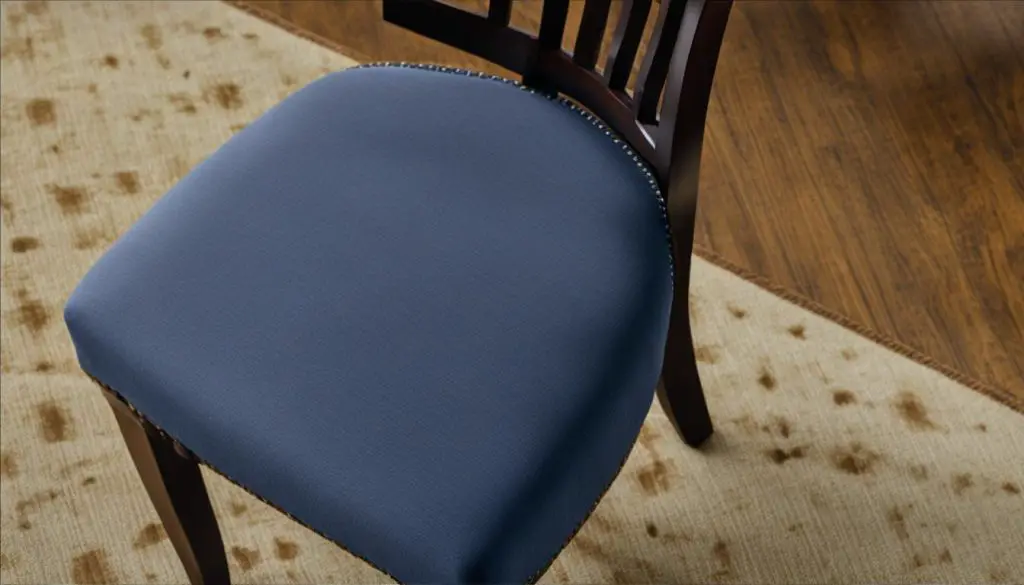
Conclusion
Cleaning upholstered dining chairs can seem like a daunting task, but with the right approach, you can keep your chairs looking spotless and extend their lifespan.
Always remember to check the upholstery codes as shown above before attempting any cleaning. This will ensure that you use the appropriate cleaning solvents and methods based on the fabric of your chairs. Being proactive in treating stains as soon as they occur is also crucial to prevent them from setting in.
FAQ
What are upholstery codes, and why are they important?
Upholstery codes provide cleaning guidelines based on the fabric of the dining chairs. It’s crucial to follow these codes to ensure the proper cleaning method and avoid damaging the upholstery.
How do I vacuum my upholstered dining chairs?
Use the upholstery attachment or a brush attachment on your vacuum to gently sweep the upholstery from top to bottom. Pay attention to crevices and corners to remove any loose crumbs or hair.

